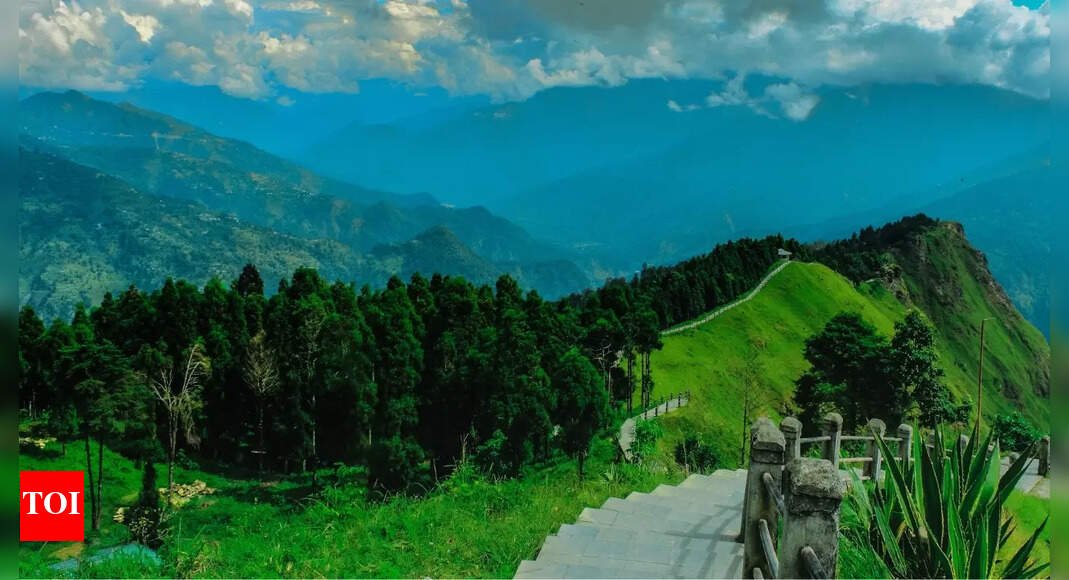Travel Guides & Articles
India’s Travel Economy Surpasses All Expectations With Exceptional Growth Milestones And Record Employment Driving A Bold Tourism Revolution

Monday, June 9, 2025
India’s Travel and Tourism industry has recorded explosive growth, shattering all expectations with record international visitor spend and tremendous economic impact in 2024. As tourism has become a leading driver in the country’s economy, India has become a world leader, establishing new growth benchmarks for prosperity. India’s historic growth in domestic and international travel marks a dynamic shift, with record job creation and innovative industry growth, making India a leading player in the international tourism sector. The historic growth within the sector is just one beginning, with its course ensuring a bold, prosperous future for travellers as well as for the country’s economic prosperity.
India’s Travel and Tourism Sector Soars to New Heights as International Visitor Spend and Economic Impact Break All Records
India’s Travel and Tourism sector has entered an unprecedented era of growth, according to the latest Economic Impact Research (EIR) released by the World Travel & Tourism Council (WTTC). The data reveals that international visitor spending surged to a record ₹3.1 trillion in 2024, surpassing the pre-pandemic peak of 2019 by 9%. This milestone marks a powerful resurgence in international travel demand and highlights India’s growing reputation as a global tourism powerhouse.
International Tourism Surges Past Pre-Pandemic Levels
Following several years of dependence on domestic travel during the pandemic recovery, India’s international tourism market has not only rebounded—it has exceeded expectations.In 2024, the sector’s overall economic contribution reached approximately ₹21 trillion, marking an impressive 20% growth compared to 2019. This positive trend is expected to continue, with no indication of slowing down. Projections indicate that Travel and Tourism’s economic footprint in India will grow to more than ₹22 trillion in 2025, with even stronger figures expected by 2035.
In 2024, the country welcomed 20 million international tourists—2.3 million more than the high recorded in 2019. This dramatic increase affirms renewed global confidence in India as a world-class destination, combining heritage, culture, and modern experiences to attract travelers from every continent.
Domestic Travel Remains a Powerhouse
While the return of international tourism has fueled new momentum, domestic travel remains the foundation of the country’s tourism ecosystem. In 2024, domestic visitor spend hit ₹15.5 trillion, an impressive 22% rise compared to 2019. This sustained domestic demand has not only kept the industry afloat during difficult years but has positioned it to thrive as international markets reopen.
The WTTC’s analysis further notes that India’s domestic market is crucial in diversifying tourism offerings, spreading economic benefits across regions, and fostering a more resilient tourism economy. The continued strength of local travel underlines the evolving preferences of Indian tourists, who increasingly seek luxury, sustainability, and unique cultural experiences.
Record-Breaking Employment and Economic Impact
The sector’s growth has also had a transformative impact on employment. In 2024, the Travel and Tourism sector played a pivotal role in generating nearly 46.5 million jobs in India, accounting for 9.1% of the country’s total workforce—marking a historic milestone. These jobs span a wide range of industries, including hospitality, transport, events, food services, and technology.
With AI and automation reshaping the future of work, the human-centric nature of the tourism industry offers vital employment opportunities, particularly for India’s young and educated population. WTTC projects that by 2025, the sector will support over 48 million jobs, and by 2035, this figure could soar to nearly 64 million, showcasing tourism’s potential as a long-term employment engine.
Business Travel Gains Momentum
India’s business travel segment is also experiencing robust growth. Combined domestic and international business travel spending hit ₹1.1 trillion in 2024, surpassing 2019 levels by 2.6%. This increase points to a resurgence in corporate travel, conferences, and MICE (Meetings, Incentives, Conferences, and Exhibitions) events, all of which play a critical role in attracting global investment and strengthening India’s economic position.
As India continues to rise as an economic and technological hub, the integration of business travel with tourism infrastructure offers immense potential. The WTTC urges stakeholders to further invest in business-ready facilities, seamless connectivity, and hospitality training to ensure continued competitiveness in this fast-evolving segment.
Infrastructure and Innovation Remain Key Drivers
To unlock the sector’s full potential, strategic investments in infrastructure remain essential. High-speed rail networks, smart mobility solutions, improved airport capacity, and regional connectivity are crucial to supporting continued growth. These developments not only ease movement for travelers but also enhance the overall tourism experience.
In addition, the rise of homegrown entrepreneurship, particularly in areas like luxury travel, eco-tourism, and experiential offerings, is helping India carve a unique identity on the global stage. Small and medium-sized enterprises (SMEs), which form the backbone of the industry, are fueling grassroots innovation and driving tourism growth in emerging regions.
WTTC emphasizes the importance of nurturing these enterprises through consistent policy support, access to capital, and digital tools that allow them to reach wider audiences. By empowering local communities, tourism can become a powerful catalyst for inclusive and sustainable development.
Future Forecasts Signal Continued Growth
Looking ahead, India’s tourism sector is on track to nearly double in size over the next decade. By 2035, the industry’s total economic contribution is expected to reach just under ₹42 trillion. The sector’s workforce is projected to expand significantly as well, providing employment to almost 64 million people.
International visitor spend is forecast to grow to ₹3.2 trillion in 2025, while domestic travel expenditure is set to climb to ₹16 trillion. These figures highlight India’s ability to capture growing demand from both local and global travelers and solidify its status as a tourism giant in the making.
A Call for Policy and Promotional Support
Despite these achievements, WTTC has raised concerns regarding recent cuts in funding for overseas tourism promotion. The organization calls on the Indian government to reconsider this move and instead match the sector’s remarkable performance with sustained policy and promotional backing.
Targeted marketing campaigns, streamlined visa processes, public-private partnerships, and consistent government engagement are vital to keep India competitive on the global tourism map. WTTC warns that without such support, the momentum gained over the past year could be difficult to maintain.
Conclusion
India’s Travel and Tourism sector has not only recovered from the pandemic—it has emerged stronger, more dynamic, and more influential than ever before. With record-breaking international visitor spend, unprecedented employment numbers, and unmatched economic impact, the industry is poised to play a central role in India’s economic narrative.
Tourism in India has broken all-time records with unprecedented growth, record-breaking visitor spend, and historic economic contributions making India one of the world’s leading tourism powers. India’s rapid growth marks a daring new era of prosperity and possibility for the country’s economy.
To ensure continued success, the WTTC urges unified action across government and industry leaders. With the right investments, consistent policy support, and focus on innovation and sustainability, India is positioned to become one of the world’s most powerful and resilient tourism economies in the years ahead.
Travel Guides & Articles
India’s TBO to acquire Classic Vacations

India based travel distribution platform TBO has agreed to acquire Classic Vacations from Phoenix-based investment firm, The Najafi Companies.
The transaction value is estimated at up to $125 million.
The acquisition brings together TBO’s technology platform and worldwide inventory with Classic Vacations network of luxury travel advisors and suppliers.
Classic Vacations delivered revenue of $111 million and an operating EBITDA of $11.2 million in the fiscal year ended December 31, 2024.
“We’re thrilled to bring Classic Vacations into the TBO family – the company’s longstanding delivery of outstanding services has earned the trust of its more than 10,000 travel advisors in the U.S,” said Gaurav Bhatnagar, TBO’s co-founder and joint managing director.
“Classic Vacations is led by a strong team of experts and will continue as an independent brand.”
“As we start working on integrating Classic Vacations with TBO, we will remain open to similar strategic alliances going forward,” added Ankush Nijhawan, co-founder and co-managing director.
Melissa Krueger, CEO of Classic Vacations, added: “Together, we’re strengthening Classic Vacations’ position as the premier luxury partner in the market while extending our reach onto the global stage.”
Classic Vacations was bought by The Najafi Companies in 2021 from Expedia Group.
Classic Vacations has a large network of high-value travel advisors and deep ties with major American consortia.
It delivers premium service across hotels, air, experiences, car rentals, and travel protection, specializing in bespoke luxury itineraries.
Related News Stories: Partner News – TravelMole
Travel Guides & Articles
Govt allows select minorities to stay in India without passport

The Union Home Ministry on Monday, September 1, issued an order announcing that the government now exempts minority communities, namely, Hindu, Sikh, Buddhist, Jain, Parsi and Christian fleeing religious persecution from Afghanistan, Bangladesh, and Pakistan, who entered the country by December 31, 2024, without requiring valid passports or travel documents.
“A person belonging to a minority community in Afghanistan, Bangladesh and Pakistan, namely, Hindu, Sikh, Buddhist, Jain, Parsi and Christian, who was compelled to seek shelter in India due to religious persecution or fear of religious persecution and entered into India on or before the 31st December, 2024,” read the order from the home ministry.
Interestingly, the order did not name Muslims. This is in line with the BJP-led government’s Citizenship Amendment Act (CAA) that was passed in 2019 to facilitate this. It had le to severe protests from Muslims and other citizens who said the law is discriminatory in nature and that it can also be misused to disenfranchise Muslims in the country.
In fact, over the last few months the central government and BJP-led state governments have been targeting Indian Muslims from West Bengal who were being picked up on false allegations of being Bangladeshi citizens. Several prominent activists including Umar Khalid and Sharjeel Imam are currently in jail having spent nearly five years in prison on charges of inciting riots in Delhi amid the anti-CAA protests.
It was issued as part of a series of directives made public by the Union Home Ministry, under the newly enacted Immigration and Foreigners Act, 2025, which came into effect on Monday, September 1.
The Immigration and Foreigners Bill, 2025, aims to grant the Union government the power to control the entry and exit of individuals into and from India by regulations that outline requirements for travel documents, such as passports, and govern various aspects of foreign nationals’ stay, including visa rules, registration procedures, and other related matters.
Previously, the Citizenship Amendment Act (CAA), which was enforced last year, extended the eligibility for citizenship only to non-Muslim minorities from Afghanistan, Bangladesh, and Pakistan who entered India on or before December 31, 2014.
While the recent directive allows certain individuals to stay in India without documentation if they arrived by December 31, 2024, it doesn’t guarantee citizenship.
In contrast, the 2019 Citizenship Amendment Act offers a path to citizenship for persecuted non-Muslim minorities from Pakistan, Afghanistan, and Bangladesh who entered India before December 2014.
The CAA’s exclusion of Muslims sparked widespread protests and concerns about discrimination, secularism, and potential disenfranchisement.
Travel Guides & Articles
Greenest destinations in India for eco-conscious travellers |

India is a haven for eco-conscious travelers seeking sustainable travel experiences. From lush rainforests to pristine Himalayan valleys, these are the places where natural beauty and responsible tourism go hand in hand. Here is a list of India’s greenest escapes, ideal for travelers who wish to explore and make the most of the outdoors while minimizing their environmental impact.
Mawlynnong, Meghalaya
Known as Asia’s Cleanest Village, Mawlynnong in Meghalaya is a model of sustainable living. Look around you and you will find bamboo dustbins. People do not litter here and they expect the tourists also to respect the village’s ways and not litter. Plastic is banned here. Take out time to explore the living root bridges, and interact with the local community. There are eco-lodges and homestays where visitors can stay, these stays offer authentic experiences.
Thenmala, Kerala
This is India’s first planned eco-tourism destination, Thenmala in Kerala’s Western Ghats offers a sustainable escape amidst evergreen forests. Also known as “Honey Hill,” it features attractions like the Thenmala Dam, Butterfly Safari Park, and Shenduruney Wildlife Sanctuary. For those interested, there are activities like boating, trekking, and rock climbing.
Sikkim
The entire state of Sikkim is a beacon of eco-tourism. Sikkim is recognized for its organic farming and conservation efforts. No wonder, it is also India’s first fully organic state. Sikkim is home to the Khangchendzonga National Park, a UNESCO World Heritage Site, which also boasts diverse flora and fauna, including red pandas and snow leopards. There is no dearth of eco-friendly guesthouses, responsible trekking opportunities, and cultural immersion with Lepcha and Bhutia communities. And last but not least, Sikkim is very clean, thanks to the eco-conscious communities.
Munnar, Kerala
Munnar in Kerala’s Western Ghats, is known for its tea plantations, lush valleys, and biodiversity. It is where you will find the rare Neelakurinji flower and species like the Nilgiri Tahr. Munnar is a great place for those seeking romantic getaways, but it is equally perfect for those seeking adventure activities like trekking and wildlife watching. Eco-resorts and sustainable practices, like waste management and local sourcing, ensure a low environmental footprint.
Spiti Valley, Himachal Pradesh
Monsoon may not be the right time to visit Spiti Valley, but come drier months, Spiti is one of the best in the country. This cold desert in the Himalayas, balances tourism with ecological preservation. Solar-powered homestays and community-based tourism initiatives support local livelihoods while protecting the fragile ecosystem. Travelers can explore ancient monasteries, trek through rugged terrains, and engage with sustainable practices, making Spiti a unique eco-destination. Here, it’s all about green energy and sustainable practices, because the greenery that comes with nature is a bit rare here, thanks to it being a cold desert.
-

 Business5 days ago
Business5 days agoThe Guardian view on Trump and the Fed: independence is no substitute for accountability | Editorial
-
Tools & Platforms3 weeks ago
Building Trust in Military AI Starts with Opening the Black Box – War on the Rocks
-

 Ethics & Policy1 month ago
Ethics & Policy1 month agoSDAIA Supports Saudi Arabia’s Leadership in Shaping Global AI Ethics, Policy, and Research – وكالة الأنباء السعودية
-

 Events & Conferences4 months ago
Events & Conferences4 months agoJourney to 1000 models: Scaling Instagram’s recommendation system
-

 Jobs & Careers2 months ago
Jobs & Careers2 months agoMumbai-based Perplexity Alternative Has 60k+ Users Without Funding
-

 Education2 months ago
Education2 months agoVEX Robotics launches AI-powered classroom robotics system
-

 Funding & Business2 months ago
Funding & Business2 months agoKayak and Expedia race to build AI travel agents that turn social posts into itineraries
-

 Podcasts & Talks2 months ago
Podcasts & Talks2 months agoHappy 4th of July! 🎆 Made with Veo 3 in Gemini
-

 Podcasts & Talks2 months ago
Podcasts & Talks2 months agoOpenAI 🤝 @teamganassi
-

 Education2 months ago
Education2 months agoAERDF highlights the latest PreK-12 discoveries and inventions





















